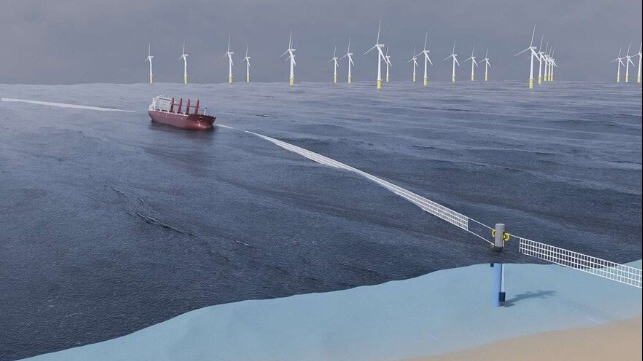Dutch Researchers Developing Maritime Crash Barriers for Wind Turbines

A team of Dutch maritime researchers is working on solutions to avoid collisions between ships and the growing number of offshore wind turbines in the North Sea. According to the team, the risk of a collision is growing rapidly as the number of wind turbines expands and they believe that they have identified several promising “crash barrier” methods to reduce the risks associated with a collision similar to one that occurred earlier this year.
“The accident involving the Julietta D shows the real dangers posed by vessels adrift,” says MARIN’s Traffic & Safety team leader Yvonne Koldenhof. “Even with current resources, it’s difficult to avoid these kinds of incidents.”
Koldenhof was referring to a Maltese-flagged bulk carrier, Julietta D, which lost control in a winter storm in the North Sea. The vessel collided with a chemical tanker that was also in the anchorage before drifting into an under construction wind farm where it hit a foundation for a future wind turbine and a transformer platform. Dutch rescuers airlifted the crew off the out-of-control vessel while Vattenfall that was building the farm later released pictures of the dents saying it would possibly have to replace the two damaged foundations.
The Maritime Research Institute Netherlands (MARIN) conducted research for the Dutch government reporting that the risk of a turbine being hit by a ship is increasing by around 1.5 to 2.5 times a year. They noted that the risk is increasingly urgent as some 2,500 wind turbines are set to be installed in the North Sea by 2030.
According to the researchers, around 80 ships are reported drifting in the North Sea each year. They noted that while the Julietta D incident did not result in a catastrophic accident, a collision with an installed wind turbine carries a real risk of the turbine toppling onto the vessel, seriously endangering crew, passengers, the ship itself, and the environment.
A group of 20 experts from MARIN and the maritime community has been researching the possible options. They point out that currently it requires active intervention by the crew to either successfully anchor a drifting ship or the rapid response by emergency towing vessels to advert the danger of collisions.
MARIN’s general director Bas Buchner explained that their mission was to go beyond simply drawing attention to the dangers in search of solutions to prevent accidents. The team developed three concepts for maritime crash barriers between shipping routes and windfarms during a February 23 workshop and now plans to work with experts from the offshore sector in refining the concepts.
The first concept involves a string of surface buoys secured by drag anchors. The second concept comprises a smart suspension net between fixed poles and the third is an anchored underwater hook line designed to catch the anchor of the drifting vessel. MARIN built scale models of all three solutions and ran tests in its Offshore Basin to see if the barriers were capable of deflecting a scale model comparable to the Julietta D in storm conditions.
“We've established that all three concepts are able to intercept the vessel,” says William Otto, MARIN's Offshore project manager. “The drag anchors of the buoy string dissipate the drift energy evenly so that the vessel stays afloat across the waves. The anchored underwater hook heads the vessel into the waves, so reducing roll. That means the vessel remains in place while being exposed to relatively low forces. The smart suspension net initially showed too much droop, but with a bit of fine-tuning, we were able to get this functioning.”
In the coming months, the researchers will go on to assess the various pros and cons of these systems. They are also sharing the information in an open forum seeking to involve the offshore sector and others to develop the concepts to protect both ships and the growing number of offshore wind turbines.
